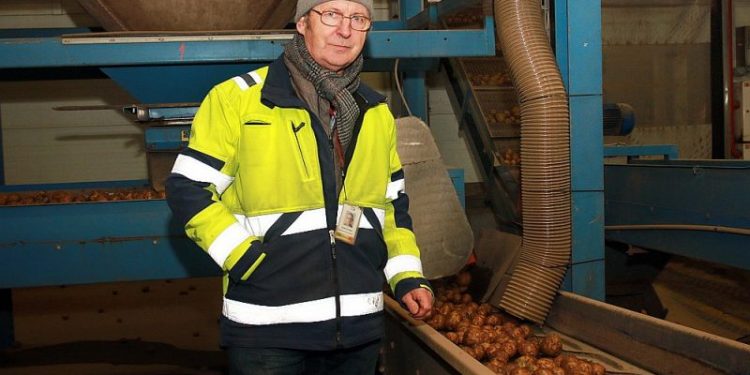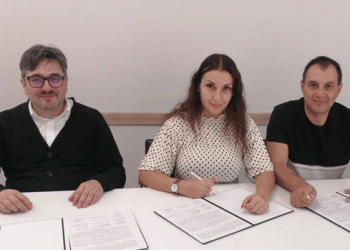Currently, chip potatoes are grown by twelve partners of SIA “Orkla Latvija”, including three Lithuanian and three Estonian owners. Latvia’s largest potato grower ZS “Briezkalni” in Ligatne is also specialized in the cultivation of chips potatoes. The farm grows chip potatoes on an area of more than 120 hectares.
SIA “Latfood Agro” is the fifth largest potato grower by area applied for support (81.25 ha). In turn, the potatoes grown by the company, already processed in the form of chips, come to stores in Latvia, Lithuania, Estonia and three Scandinavian countries.
“We see a trend – if the chip potato is grown” by the way“, then the result is also” by the way”, “reveals Ilgvars Krumins, chairman of the board of the subsidiary of SIA” Orkla Latvija”.
“The number of growers is decreasing for us, because people who grow potatoes” by the way ” often fail. In addition, growing potatoes is hard work, the investment for CHIP potatoes per hectare is close to 4,000 euros, the seed alone costs 350 euros/t. large cash investments, high risks. However, in a normal year, the profit from growing chip potatoes is very good.”
Important storage conditions
The head of the company Ilgvars Krumins, who has a scientific degree of Doctor of Agriculture, explains that, unlike table potatoes, chip potatoes have specific requirements for the amount of sugar in the potato and the storage temperature.
“The first requirement – for chips it is necessary to use varieties where there is very little sugar,” the nuances reveal the long-weight Bush. “A potato is a potato, but a potato of chips must be fried in oil at a temperature of 160-170 degrees. This means using varieties that turn pale after a day of storage baking. If reducing sugars – glucose and fructose – are present, they caramelize, turn brown, and the slice of chips looks brown. It does not meet quality requirements.”
The second requirement-careful monitoring of storage temperature. Usually potatoes are stored at a temperature of +4 degrees, because then there are the least losses, while Chip potatoes are stored at a temperature of + 7-9 degrees. “As the temperature drops, breathing decreases, but the cleavage of starch into sugars increases.
If the temperature approaches 0 degrees for a potato, it thinks about freezing and gives off, breaks down a lot of sugars.
For example, when they stand, the potatoes that got Frost are sweet after cooking and after frying they are hundreds of times too sweet,” explains Ilgvars Krumins. “At four degrees, sugars break down quite a bit. If the temperature is raised to + 8 degrees, this is a safe zone.”Breeders, however, are looking for varieties that can be stored at lower temperatures, however, there have been no breakthroughs in recent decades.
Chips are produced when they can be sold, when people want to enjoy them. In Latvia, people eat the most chips in summer when they go out into nature. The maximum consumption is in June, July and August. In turn, the time for harvesting potatoes is September. To ensure the availability of chips in summer, potatoes must be stored until production around the Midsummer Festival. The chip potato must have a good dormant period.
In terms of yield, all varieties of chips have a lower yield potential than most table varieties. A common regularity works – if there is more dry matter in a potato, then a ton of harvest per hectare is less. Super-productive table varieties have very little dry matter. Their large mass is given by water.
In Europe, there are about 1,500 varieties of potatoes. There are 50-60 varieties in circulation in Latvia, but there are less than ten varieties of chips. What varieties choose “Latfood Agro”for cultivation? “We and our colleagues in other chip factories have 4-5 very good varieties in the assortment, but also each with its own shortcomings, which is normal,” reveals Ilgvars Krumins.
‘Lady Rosetta’is currently the most popular farm at the ‘early end’. The next very popular variety is ‘Lady Claire’, which occupies about a third of the farm plantings. Due to its low and always stable sugar content, it is a very popular variety throughout Europe. The assortment of” Latfood Agro ” also includes the ‘Kiebitz’variety.
“Very good because it is relatively early, is less drought sensitive than ‘Lady Claire’ and always with a very optimal amount of dry matter. However, ‘Kiebitz’ has its own fault – it forms tubers very shallowly and has a very high proportion of green tubers in the crop. Everything is very good in the potato, except for the green color. There is solanine, which is only harmful, so the green tubers must be removed, ” says Ilgvars Krumins.
Last year, for the first time, they started breeding the ‘Sorrentina’ Variety on a large scale, however, it seems to be a little disappointing. “Every year, in cooperation with Finnish colleagues, we plant chip potato varieties in two 40-meter-long furrows, which we test as potential for the production of chips,” reveals Ilgvars Krumins.
“We evaluate how potatoes grow, how they produce, harvest and weigh the harvest, compare the results of varieties.
Yield is not the most important condition, just appreciate the potential.
Then we put the potato in the storage – the most important condition for choosing is a stable amount of sugar during storage. If there are no sugars and bake well – there is a light color, then dry matter is important.”
All currently grown varieties of chips are quite chimperliga and susceptible to rotting of bream. “For this reason, next season, for the first time, we will plant a new variety on an area of 20 hectares – ‘Beyonce’, created by the Dutch company “Agrico”. We are one of the first in Europe to use this variety for commercial purposes,” it Longvars Krumins.
“Although we grow different varieties of chips, they should not be confused. Each has its own characteristics, each is baked differently, and each variety is also stored differently. We would like it so that potatoes grow in the field for one year, grain or rapeseed for two years, or something else. It doesn’t work out like that, it is more often one year with another crop among others, because we have fields where potatoes cannot be planted anyway. We have also sown oil radish as fallow. Sowed in late spring, plowed in autumn, and potatoes are planted the next year. This is an option, only there is no income per hectare.”
Also grown for seed
“Orkla Latvija” also provides chip potato growers with seed. “We buy an elite class seed and multiply it for one year, ” explains Ilgvars Krumins.
“This is done by four farms from which we buy back the seed. We get a Grade A Seed, sell it to our farmers, they plant and take the crop to processing. Our colleagues in Sweden, Denmark and Finland immediately buy category a seed from a breeder. Why did we choose another model? The answer is-cost.”
The farm, however, does not earn its own seed. “We created this model to reduce the price of the seed so as not to overexpose the product. But propagation is also not without risks. The longer the cultivation in the open field and if you do not protect the area against viruses, the more the quality of the seed falls. For one year of production, this model works. We established such a model at the very beginning of operation,” reveals Ilgvars Krumins.
Competing with solar panels
The company leases all cultivated land from 20 landowners. “Since 2003. since 2009, we started renting land, we started with an area of 40 hectares. Initially, there were five-year land tenancies. Currently, people mainly conclude land leases for 1-2 years. With the idea – what if you manage to sell the land,” says the head of the agricultural company.
“And some also sell.
In the past, land was usually sold for construction, currently – for the installation of solar panels.
Most likely, we will lose 12 hectares from our leased land, since the owner will lease the land for the installation of solar panels. In the advertisements we see that the solar panel operator promises to pay a rent of 800 euros/ha in the next 20 years. There is no way we can offer such a fee. In other countries, solar panels are not installed on arable land. Currently, there is no regulation in this direction in Latvia.”
A source: https://www.la.lv








